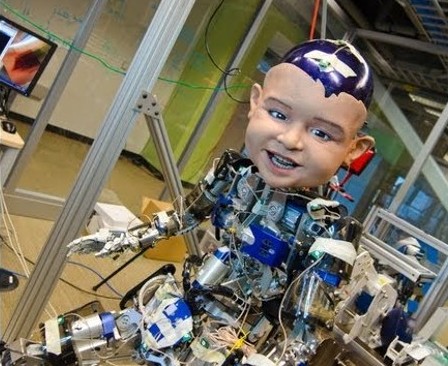
Cloud robotics is an absolute must if driverless cars and the Internet of Things are going to take off, but it’s also an invitation to mayhem, heretofore unimagined acts of terrorism and war. In Quentin Hardy’s New York Times interview with Berkeley roboticist Ken Goldberg, various angles of the topic are analyzed. The opening:
“Question:
What is cloud robotics?
Ken Goldberg:
Cloud robotics is a new way of thinking about robots. For a long time, we thought that robots were off by themselves, with their own processing power. When we connect them to the cloud, the learning from one robot can be processed remotely and mixed with information from other robots.
Question:
Why is that a big deal?
Ken Goldberg:
Robot learning is going to be greatly accelerated. Putting it a little simply, one robot can spend 10,000 hours learning something, or 10,000 robots can spend one hour learning the same thing.
Question:
How long has this been around?
Ken Goldberg:
The term ‘cloud robotics’ was coined in 2010 by James Kuffner, who was at Carnegie Mellon and then went to Google. I had been doing robot control over the Internet since the mid-90s, with a garden people could connect to, then plant seeds or water their plants.
The cloud is different from my Internet ‘telegarden,’ though. The cloud can have all the computation and memory stored remotely. That means all of the endpoints can be lightweight, and there is a huge collective benefit. These robots can address billions of behaviors and learn how to do important things quickly.
Question:
What are some examples of this?
Ken Goldberg:
Google’s self-driving cars are cloud robots. Each can learn something about roads, or driving, or conditions, and it sends the information to the Google cloud, where it can be used to improve the performance of other cars.
Health care is also very promising: Right now radiation treatments involve putting a radioactive seed next to a tumor, using a catheter that has to push through other tissue and organs. The damage could be minimized if the catheter worked like a robot and had motion planning to avoid certain objects. Tedious medical work, like suturing a wound, might be done faster and better. Giving intravenous fluids to Ebola patients is difficult and risks contamination; some people are looking at ways a robot could sense where a vein is and insert the needle.
Another area is household maintenance, particularly with seniors. Robots could pick up clutter, which would help elderly people avoid falling and hurting themselves.”


